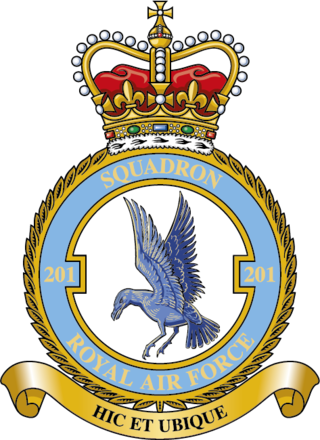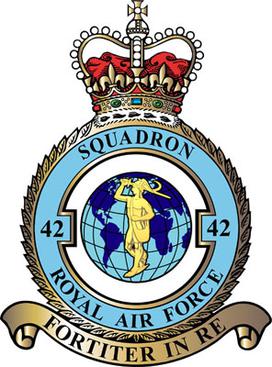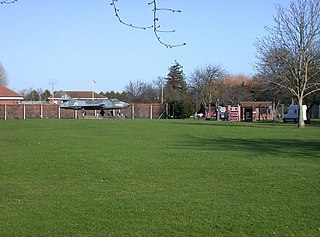
The Royal Air Force (RAF) is the United Kingdom's air and space force. It was formed towards the end of the First World War on 1 April 1918, becoming the first independent air force in the world, by regrouping the Royal Flying Corps (RFC) and the Royal Naval Air Service (RNAS). Following the Allied victory over the Central Powers in 1918, the RAF emerged as the largest air force in the world at the time. Since its formation, the RAF has taken a significant role in British military history. In particular, during the Second World War, the RAF established clear air superiority over Hermann Göring's Luftwaffe in the Battle of Britain, and led the allied strategic bombing effort.

The Army Air Corps (AAC) is the aviation arm of the British Army, first formed in 1942 during the Second World War by grouping the various airborne units of the British Army. Today, there are eight regiments of the AAC, as well as two independent flights and two independent squadrons deployed in support of British Army operations around the world. Regiments and flights are located in the United Kingdom, Kenya, and Canada. Some AAC squadrons provide the air assault elements of 16 Air Assault Brigade, through Joint Helicopter Command.

Leuchars Station is a British Army installation located in Leuchars, Fife, on the east coast of Scotland, near to the historic town of St Andrews.

Royal Air Force Lossiemouth or more commonly RAF Lossiemouth is a military airfield located on the western edge of the town of Lossiemouth in Moray, north-east Scotland.

Royal Air Force Kinloss, or more simply RAF Kinloss, is a former Royal Air Force station located near the village of Kinloss, on the Moray Firth in the north east of Scotland, UK.

The Royal Air Force Regiment is part of the Royal Air Force and functions as a specialist corps. Founded by Royal Warrant in 1942, the Corps carries out soldiering tasks relating to the delivery of air power. Examples of such tasks are non-combatant evacuation operation (NEO), recovery of downed aircrew, and in-depth defence of airfields by way of aggressively patrolling and actively seeking out infiltrators in a large area surrounding airfields. In addition the RAF Regiment provides Joint Terminal Attack Controllers (JTACs) to the British Army in the Tactical Air Control Party (TACP) role, and provides flight size commitment to the Special Forces Support Group.

Number 201 Squadron is a squadron of the Royal Air Force. It currently operates the Boeing Poseidon MRA1 from RAF Lossiemouth, Moray.

Number 42 Squadron, also known as No. 42 Squadron, is a squadron of the Royal Air Force. It reformed at RAF Lossiemouth on 21 September 2023 as the Operational Conversion Unit for both the Boeing Poseidon MRA1 and Boeing Wedgetail AEW1.

Number 120 Squadron or No. CXX Squadron is a squadron of the Royal Air Force which was established as a Royal Flying Corps unit late in World War I, disbanded a year after the end of the war, then re-established as a RAF Coastal Command squadron during World War II. Although disbanded again a month after Victory in Europe Day, during and after World War II it operated almost continuously, with maritime patrol aircraft; most recently with the Hawker Siddeley Nimrod, based at RAF Kinloss in Scotland until the type's withdrawal in March 2010. The squadron was disbanded again the following year. No. 120 Squadron stood up again in April 2018 at RAF Lossiemouth and became the first squadron to be equipped with the Boeing Poseidon MRA1 anti-submarine warfare (ASW) aircraft on 31 October 2019.

Royal Air Force Catterick or RAF Catterick is a former Royal Air Force airfield located near Catterick, North Yorkshire in England. It is located alongside the A6055 road on the outskirts of Catterick Village.

Royal Air Force Elgin or RAF Elgin, also known as Bogs of Mayne, is a former airfield operated by the Royal Air Force and located approximately 1.5 kilometres (0.93 mi) south west of Elgin in Moray, Scotland. It opened in 1940 as a satellite airfield of RAF Lossiemouth and was used throughout the Second World War, predominantly by bomber aircraft of No. 20 Operational Training Unit. Towards the end of the war it was used by No. 46 Maintenance Unit, before it closed in 1947. The site was returned to agricultural use, although several airfield buildings and a memorial remain.

Waterbeach Barracks is a former military installation in Waterbeach, Cambridgeshire. The site was an RAF Station, RAF Waterbeach and then used by the Royal Engineers, part of the British Army, from 1966, until 2013 when the site closed to make way for housing.

Ministry of Defence Woodbridge or MoD Woodbridge is a military installation located near the town of Woodbridge, in Suffolk, England. The site opened in 2006 and is operated by the British Army and incorporates both Rock Barracks and Woodbridge Airfield. The barracks are home to two Royal Engineers regiments. The airfield is used periodically by helicopters of the Army Air Corps for training exercises.

8th Engineer Brigade is an engineering support formation of the British Army, which forms part of 1st Division.

Royal Air Force Leuchars or more simply RAF Leuchars is a former Royal Air Force station located in Leuchars, Fife, on the east coast of Scotland. Throughout the Cold War and beyond, the station was home to fighter aircraft which policed northern UK airspace. The station ceased to be an RAF station at 12:00 hrs on 31 March 2015 when it became Leuchars Station and control of the site was transferred to the British Army. The RAF temporarily returned to Leuchars between August and October 2020 to carry out QRA (I) responsibilities while runway works were being carried out at RAF Lossiemouth.

Exercise Joint Warrior is a major biannual multi-national military exercise which takes place in the United Kingdom, predominately in north west Scotland. It is the successor of the Neptune Warrior exercises and Joint Maritime Course.
At the end of the Cold War in 1989, the Royal Air Force (RAF) structure was as follows:
This is the structure of the Royal Air Force, as of October 2020.

This is a list of active military units, bases and barracks in Scotland. The armed forces in Scotland include the military bases and organisation in Scotland or associated with Scotland. This includes servicemen and women from Scotland and Scottish regiments and brigades of the British Armed Forces. The Military in Scotland includes the three services. The Army which has bases across Scotland, the RAF and the Navy.

















